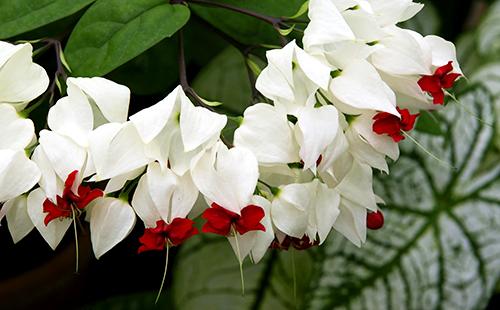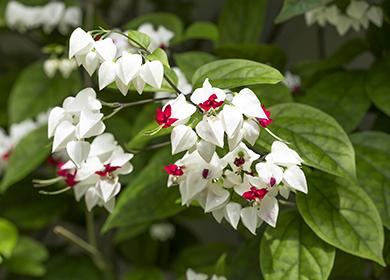The content of the article
In the literature, this species is called Madame Thomson's clerodendrum. The semi-deciduous liana with original leaves and flowers grows very quickly and is easy to shape. It is found in nature in the tropical forests of West Africa.
Description and Features
In nature, Thompson's Clodendrum creepers stretch up to 4 m. This is facilitated by a warm climate without strong temperature fluctuations, increased humidity, and optimal amount of sunlight. In apartments, growth is limited artificially - by trimming and pinching.
Thompson's Clodendrum blooms with small flowers of five petals surrounded by voluminous bracts. Flowers are gathered in axillary brushes. Foliage is also very decorative. The colors of the leaves are mostly dark green. Varieties with variegated and purple leaves are found. The distinctive feature of clerodendrum is the “quilted” texture of the leaf surface due to deep, distinct veins.
Thompson's Clodendrum blooms closer to mid-spring, finishes blooming in the fall. Depending on the variety, flowers and bracts can be of different shades. Corollas do not last long. After their fall, beautiful bracts of white, burgundy, pink or lilac shade remain on the bush. The fruits are small, orange. Each fruit carries one seed. Seeds are suitable for propagation.
Actions after the purchase
How to care for Mrs. Thompson's clerodendrum after purchase? It is advisable to quarantine - set separately from other colors. Quarantine is recommended for any plant brought into the house. It helps to identify pests, diseases, avoid infection of other flowers.
For easy adaptation, clerodendrum is placed in a well-lit, but not sunny place. Watering moderately - the soil should be evenly moist, but not wet. The temperature is maintained at 20 ° C. Feeding the first month after purchase is not necessary.
The duration of adaptation is from one to two weeks, depending on the initial state of the plant. After adaptation, the clerodendrum is transplanted into a suitable soil and placed in a permanent place.
Thompson Clodendrum Care: Key Tips
A good result is the cultivation of Thompson's Clodendrum at home, taking into account its natural needs. Full lighting, favorable temperature and air humidity stimulate growth, support the decorativeness of the plant.
- Lighting. The light is diffused but bright. Open sunlight is avoided. Burns form on the leaves from the sun. Good location - east and west windows. It is dark on the north side of the clerodendrum, and hot on the south.
- Temperature. In summer, it perceives well the average room temperature of 10-25 ° C. Wintering should be cool - no higher than 15-18 ° C. The warm content in winter makes flowering difficult.
- Watering. During the period of growth and flowering, water abundantly. They try to maintain stable soil moisture without drying out and waterlogging. When the earth is completely dry, the leaves fade, leaves fall. Dampness leads to rotting of the root system. They do not take cold water for irrigation; it should be at room temperature.
- Air humidity. Regular spraying is a mandatory procedure to maintain the decorativeness of clerodendrum. In winter, the flower should not be placed near batteries or radiators. Humidity is increased by using special humidifiers, the placement of plates with water. The pot with clerodendrum can be put in a tray with wet pebbles.
- Top dressing. In spring and summer they feed weekly. Mineral and organic fertilizers for flowering plants alternate. Occasionally, foliar top dressing is performed on the leaves.
- Transfer. Clerodendrum grows rapidly, transplanted annually. The soil is completely replaced, the pot is taken in a larger size. It is not necessary to transplant adult plants formed in the form of vines every year. Instead of replanting, replace the topsoil.
- The soil. The main requirements for the soil are lightness, nutrition, breathability, pH 5-6.5. You can use store primers for azaleas and roses. At home, the substrate is prepared from an equal amount of peat, sand, turf, humus (well rotted) and leafy soil.
What you need for abundant flowering. Signs and superstitions
In adverse conditions, Thompson's Clodendrum does not bloom. The most common mistake novice gardeners make is to neglect the winter dormant phase. In the warmth, flower buds are not laid, flower stalks do not appear in spring. In winter, the flower should be in a cool room. In total, there are three reasons for the lack of flowering:
- warm wintering;
- incorrect or insufficient trimming;
- lack of nutrients (potassium and phosphorus).
In order to make Thompson's Clodendrum bloom, at the end of autumn it is rearranged in a cool room, watering is limited. The soil should be slightly moist. It can be cut in the fall before the dormant period or in the early spring before the start of active growth. In spring, clerodendrum is returned to heat, watering is intensified. After the first buds appear, they begin to make mineral fertilizers.
Flowers are formed on new shoots, so in spring or autumn, all lashes of the clerodendrum are cut by a third. Without pruning, cold wintering, and regular transplanting, the clerodendrum will not bloom.
How to propagate
Thompson's clerodendron can be propagated by cuttings and seeds. Seeds collected independently sprout well, retain all the characteristics of the species. Sowing seeds is less commonly used due to the slow growth of seedlings.
Cuttings
Features. Cuttings are carried out in spring or autumn at the same time as pruning. Spring is a more favorable time for rooting and the beginning of growth. To root Mrs. Thompson's clerodendrum is easiest with grassy apical cuttings. For faster rooting, the container with planted cuttings is covered with a film or a plastic cup. Daily shelter is removed, condensate is removed, aired.
Action algorithm
- The tops of shoots with two or three internodes are cut with a sharp tool. The optimal length of the handle is up to 6 cm.
- Prepare a substrate of sand, turf and humus.
- Cuttings are installed vertically in moist soil.
- The soil is regularly moistened, maintain a temperature of 22-25 ° C.
Seeds
Features. A plant can be grown from seeds collected from its plant. A good time for planting is spring. Seeds germinate quickly even without first soaking and using stimulants.
Action algorithm
- A low wide container is filled with a light soil mixture.
- Seeds are laid out on the surface, sprinkled with a thin layer of soil.
- Humidify the soil with a spray bottle, cover the container with a transparent film.
- After emergence, weak plants are harvested.
- At the stage of four true leaves, they are seated in separate containers.

Trimming and Shaping
In young plants, pinch the tips of the shoots. Adult plants need hard pruning. It is not necessary to feel stingy with the clerodendrum - it recovers well after pruning, and it launches many side shoots. All stems are cut to a third of their length. Inflorescences form on the lateral one-year shoots.
The natural form of Thompson's clerodendrum is a liana. At home, it can be grown as an ampel plant with free-hanging lashes or fixed on a support, setting the desired direction of growth. Clerodendrum is easy to shape - it can be shaped like a bush or a standard tree.
- Stamp form. In a young plant, only one strong shoot is left, they are tied to a vertical support, the rest are completely cut out. Upon reaching a half-meter height, the top is cut off. The growth points of subsequent lateral shoots need to be clipped for more intensive branching. All shoots below the desired crown level are systematically removed.
- Bush. During annual pruning, all the shoots of the clerodendrum are shortened to the desired height. Pinch the side branches to get a thicker bush.
Growing problems
Clerodendrum is not afraid of disease - it is resistant to most fungi, viruses and infections. The danger can be typical pests of indoor plants - aphids, spider mites and whiteflies. With the timely detection of insects, a single treatment with insecticides helps.
More often, one has to deal with the consequences of improper, neglectful care. The main problems, their causes and solutions are given in the table.
Table - Problems in growing clerodendrum
| Problem | Probable reasons | Help the plant |
|---|---|---|
| Leaves turn yellow | - lack of moisture in the soil; - dry air in the apartment; - excess fertilizer; - lack of light; - direct sunlight | - Regular spraying; - systematization of irrigation; - adjustment of care in accordance with the recommendations |
| Leaves fade, fall off | - Strong drying of the soil | - Support for stable soil moisture |
| Leaves turn black | - Root burn with fertilizers - root decay | - Transplantation with the removal of damaged roots |
| The plant drops leaves and buds in the summer | - Drafts; - lack of moisture; - low humidity; - nutrient deficiency | - Regular spraying with warm water; - regular top dressing with mineral and organic fertilizers |
| Chlorosis of the leaves is manifested (grinding, twisting of leaves, the appearance of spots) | - Lack of trace elements | - Spraying with iron fertilizers |
| Shoots stretch | - lack of light | - Moving the flower closer to the window; - providing additional illumination |
| Stains appear on the leaves | - Sunburn; - pests; - cold air; - fungus | - Inspection for pests and plaque; - moving to a warm place protected from the sun |
Since taking care of Thompson's clerodendrum is quite simple, it can be used to decorate offices. It looks impressive in spacious, well-lit rooms.

